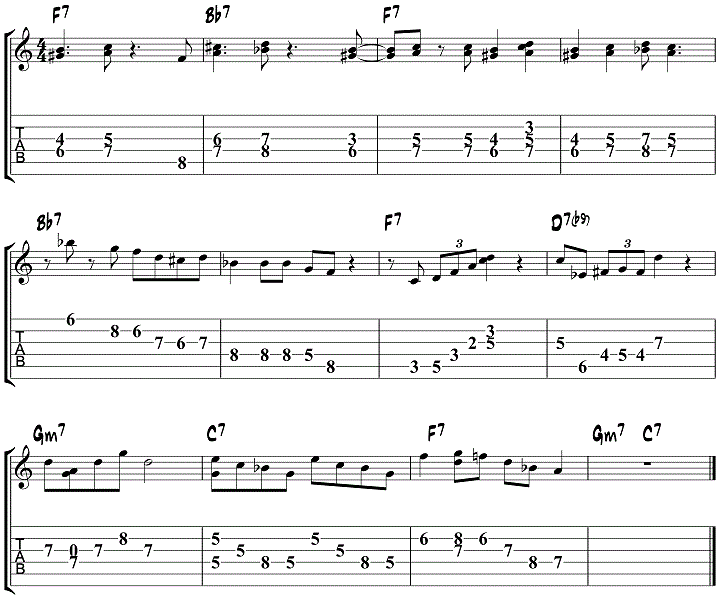Though not a guitarist, Thelonious Monk is one of the most commonly studied jazz musicians when guitarists begin to explore improvisational and compositional techniques on the instrument. With a strong focus on polyphonic lines, playing two or more notes at once, as well as a unique rhythmic approach to improvising, Monk’s lines are full of material that can be translated from the keyboard to the fretboard as you expand your jazz guitar soloing vocabulary.
To help you add a bit of Monk to your improvised lines and phrases, here are five classic Monk lines over major ii V I and minor ii V I progressions, as well as static dominant 7th chords that you can study, break down to their component parts and add to your jazz guitar soloing ideas today.
As well, to help bring these licks to life, there is a sample blues solo at the end of the lesson that you can use as a vehicle to begin taking these lines from the practice room to the bandstand in your own playing.
Thelonious Monk Lick 1
This first Monk lick features a nice double-stop (B-C) in the first bar that is characteristic of Monk’s playing and something that translates well to the guitar fretboard.
In the second measure, you can see the Edim7 arpeggio being used to outline a C7b9 chord in this setting.
Playing a dim7 arpeggio from the 3rd of a dominant 7th chord is something that Monk, and just about every jazz musician, uses to bring a rootless 7b9 sound to their lines and phrases.
| E Diminished Arpeggio | E | G | Bb | Db |
|---|---|---|---|---|
| Played over C7 | 3 | 5 | b7 | b9 |
Finally, there is a #7 interval in the last bar over Fm7 (E) which implies a melodic minor sound at this point in the phrase, a commonly used sound in Monk’s lines.
Thelonious Monk Lick 2
The next idea (played over a ii V I in Eb) mixes both major and minor ii V I chords, something that you can find in Monk’s playing and soloing.
Here, there is a iim7b5 chord (Fm7b5 in bar one) followed by a Bb7 and then finishing with an Ebmaj7 in the last two bars of the phrase.
Over the Fm7b5, there is an emphasis on the 11th note in the arpeggio line, creating an Fm11b5 sound, which is then followed by a plain Bb7 arpeggio in the second bar.
Finally, the line finishes with a #5 note (B), resolving to the 6th of the chord (C), using an approach note to create tension and release at the end of the lick.
Thelonious Monk Lick 3
This ii V I line, featuring only chords from the tonic major key this time, uses two common Monk techniques in its construction.
The first is the intervallic pattern played over the Fm7 chord in bar one of the line.
Next, there is a repetitive lick in the second bar that outlines the Bb7 chord in that part of the phrase.
Thelonious Monk Lick 4
This lick is played over the first four bars of a blues in F and has a lower neighbor tone in bar one that circles around the 3rd of the F7 chord.
In bar three you can see a Dm7 arpeggio outlining the 6-1-3-5 notes of the underlying chord, before resolving to the 13th as the last note in the phrase.
Thelonious Monk Lick 5
The next lick is a double-stop idea (playing two notes at once) that outlines a four-bar F7 chord.
Notice the half-step movement between the double stops that creates Monk’s characteristic tension and release sound in this line.
Thelonious Monk Solo
To help you get started with applying these licks to a musical situation, here is a sample solo played over one chorus of a jazz blues in F that uses licks from this lesson to construct the solo as a whole.
Once you have worked out this sample solo, try writing your own solos based on the 5 licks in this lesson, over the Blues if that’s in your repertoire, or over any standard that you know or are working on.








Are these licks actually lifted from Monk recordings or are the in the style of Monk?
They’re taking from recordings and adjusted to fit the guitar fretboard and adjusted for length.
This is an AWESOME website!I have learned so much that I can’t begin to thank you enough!There is a wealth of info and I have only scratched the surface!I love you for putting up this website!
To hear what Monk would sound on a guitar, listen to Peter Bernstein album simply called “Monk”.
Thank you Dirk! I study your lessons for about two weeks, and I already sound better! God bless you man!
Thanks all your good work on this page. Monk is cool!
thanks I practiced 3 of them and 2 more left for tomorrow !
Neat!
am yet going to try it. i love licks. keep it up. latterr
It was very good exercise for my brain, especially Lick 4,5,6.
Lick #6 uses a lot of what I like to play. Keep bringing this style. It keeps things fresh.
Great examples! Keep ’em coming!
Thank you, wonderful Licks !, I will try to play.
The sound is perfect on my computer — I’m on Apple Mac, I don’t now if that makes any difference. My favourite licks are 4, 5 and 6; they seem full of warmth. Many thanks for another inspiring – and very useful – lesson.
Great lines. Love so much Monk for the way he use this colour in in all his phrases !!!!
Great lesson especially lick 5
Tasteful licks, everyone and presented really well. Thanks very much.
look foward to your lesson man ! Rob !
Great licks , I can”t play the head on ” Straight no Chaser” either !
i”m afraid the sound quality on the samples is distorted especially
on tha double stops ?
Thanks, I’ve got my speakers and soundcloud volume all the way up and don’t hear the distortion. Maybe try going to soundcloud, just click the little soundcloud word in any example and then in the upper right corner you can adjust the volume for all future tracks. The issue might be on the site’s volume level.
love em all,the solo at the end is awesome thanks for sending these
yeah, thanx for the licks, they’re good for violin 2 🙂
Monk is the first great jazz player I heard. After taking up the guitar I had given up on the idea that the instrument could adapt to his sound,this raises great hope. Great lesson Mat, many thanks!
Wow, nifty lesson. Always loved Monk’s music but never thought of using many Monk licks in my own playing. (Heck, it took me forever to get the head of “Straight, No Chaser” right!) This is good stuff, and the F blues solo at the end is a real treat. Thanks!